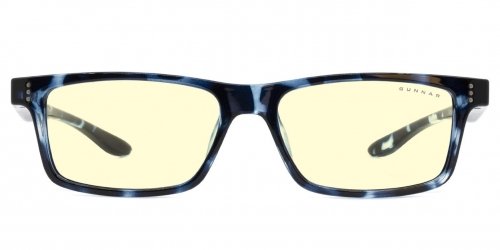Let’s face it, you’re surrounded by digital screens. What was once fantasized in sci-fi films is now a reality. From laptops to tablets to cell phones, our world has gone from analogue to digital in a matter of a handful of years. And while the convenience of having so much available at your fingertips has helped society excel in many areas, it has also caused an alarming amount of people to suffer from digital eye strain. Digital eye strain is a real-life medical condition immediately associated with exposure to artificial blue light, and according to a recent study 90% of the U.S. population is at risk of suffering from it. Symptoms include eye fatigue/tired eyes, eye strain, headaches, irritated eyes, itching/burning eyes, blurry vision, and general fatigue. As well, long-term exposure to blue light has been linked to cataracts, depression, macular degeneration, and other diseases.
To help simplify things a bit, here’s a commercial we recently did that quickly explains the condition:
Bear in mind, we’re not making any of this stuff up – digital eye strain is very real. While we coined the phrase “digital eye strain” nearly 10 years ago and the medical establishment has since accepted it as official terminology, they have done their own research which has yielded some extremely eye-opening facts about artificial blue light, how it can hurt your eyes, lead to diseases, and negatively affect your sleep. Examples of their independent studies can be read here, here, here, here, and here.
Now, the official explanation of what digital eye strain is comes from our friends at the American Optometric Association:
Computer Vision Syndrome, also referred to as Digital Eye Strain, describes a group of eye and vision-related problems that result from prolonged computer, tablet, e-reader and cell phone use. Many individuals experience eye discomfort and vision problems when viewing digital screens for extended periods. The level of discomfort appears to increase with the amount of digital screen use. Symptoms associated with Computer Vision Syndrome (CVS) or Digital Eye Strain are eyestrain, headaches, blurred vision, dry eyes, and neck and shoulder pain.
Viewing a computer or digital screen often makes the eyes work harder. As a result, the unique characteristics and high visual demands of computer and digital screen device viewing make many individuals susceptible to the development of vision-related symptoms. Uncorrected vision problems can increase the severity of Computer Vision Syndrome or Digital Eye Strain symptoms. (RE: AOA.org)

Something else to note that is at the very root of digital eye strain is the high frequency of artificial blue light bombarding your eyes. It is a lot more intense than the level you receive from the sun, and it’s also the only color wavelength that penetrates your cornea and directly hits your retina. Bad blue light ranges from 380 to 470 nanometers, but there is also good blue light which ranges from 470 to 500 nanometers. The reason it’s good is because at these frequencies, it triggers enzymes and chemicals in your brain that help promote memory and cognitive function. They also stimulate the photosensitive retinal ganglion cells that, in turn, stimulate pupillary reflexes and control the circadian cycle. This is getting pretty science-y so if you’re truly curious, you can read what the experts at All About Vision have to say about blue light in their independent analysis here. There’s also a website dedicated to explaining how blue light can be bad for you which you can find here.

What shouldn’t be flippantly disregarded, though, are the issues you could potentially suffer when exposed to blue light. These include melatonin levels being diminished leading to a disrupted sleep pattern (circadian rhythm), retinal damage, macular degeneration, cataracts, depression, and eye disease. Some studies have even shown that blue light can trigger chemical reactions in the brain that can lead to diabetes, weight gain, and even cancer. Given that the gateway for living life begins with your eyes, protecting them has never been more important.
As a result of the advancement of our technologically-inclined society and the saturation of digital devices in our lives, more and more people are feeling the negative effects. The Vision Council, the leading organization for championing better vision for better lives, does an annual study on digital eye strain and this year’s numbers are frightening. According to their researchmore than 83% of Americans use a digital device for more than two hours a day, and of those individuals, over 60% experience symptoms of digital eye strain.
In an effort to help combat the growing number of issues many digital device users experience, there has been a major push to incorporate digital solutions into technology – specifically, applications or settings which help diminish the level of artificial blue light being emitted. Some of these apps are free to use/install, while other advancements are programmed right into device settings and expensive monitors. The end result, however, is a screen that’s distinctively orangish in hue, as if it had one too many spray-tan sessions.
Granted, these advancements in tech are a great step forward in helping to combat the growing problems associated with digital eye strain and blue light, but they’re simply not enough. Digital eye strain, as was quoted above, is “a group of eye and vision-related problems”, not just a result of artificial blue light. First, your eyes are a muscle and work their hardest when looking close up at a digital device all day. It’s like running a marathon and then trying to walk home afterwards. Your leg muscles would be too fatigued to carry you let alone stop from shaking. This same principle applies to your eye muscles as well. Second, the harder you gaze at a screen, the less likely you are to blink which, in turn, dries out your eyes. It’s a medical fact that blink-rates drop significantly during intense viewing which increases irritation. Third, glare from digital screens and the fact that they flicker as you try to concentrate on tiny letters or details cause your eyes to quickly become fatigued and irritated which can even lead to headaches.
Where applications and settings let you down is in these areas. Tuning out the blue light being emitted might help a little, but it won’t stop all of the other symptoms associated with digital eye strain. These apps and expensive color-shifting monitors still shower your eyes with high levels of artificial light. Masking the color focus or shifting the light spectrum does not change the fact that devices with a screen are illuminated by spikes of artificial light including blue light. Although these solutions may shift the amount of HEV blue light produced naturally by the devices, they do not reduce it enough. Besides, if you’re looking at a color-rich image or game, you can’t honestly say you’d prefer to see it bathed in orange, right? This now leads to another problem: few people actually take full advantage of a blue-blocking app or setting. Most likely, this is due to the significant manipulation of colors in how they’re seen on screen, and so blue light is still getting through and directly hitting the retina.
When you weigh all of your options, and despite some of these applications and settings being free, you’re missing out on so much more and still hurting yourself in the long run. Realistically, these solutions only address one of the causes of digital eye strain. The big difference is that GUNNAR addresses all causes of digital eye strain. GUNNAR amber lenses block the most HEV blue light at 65% providing you with a natural viewing situation and the most protection, they add contrast to help sharpen text and images on your screens, added focusing power pre-focuses the light and reduces stress on the eyes muscles caused from close distance viewing, and our patented lens designs help hold in humidity while blocking air currents to prevent dry eyes. So, you can keep using these apps and settings if you so choose, but for full protection, you’ll want to put on a pair of GUNNAR glasses.
Get on the GUNNAR bandwagon and never again worry about having to suffer from digital eye strain. We’ll take care of your eyes so you can be a better you all day, every day.







